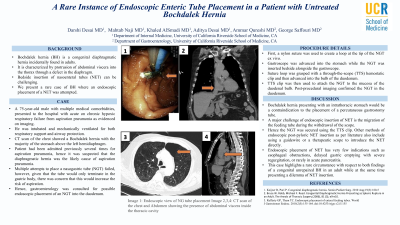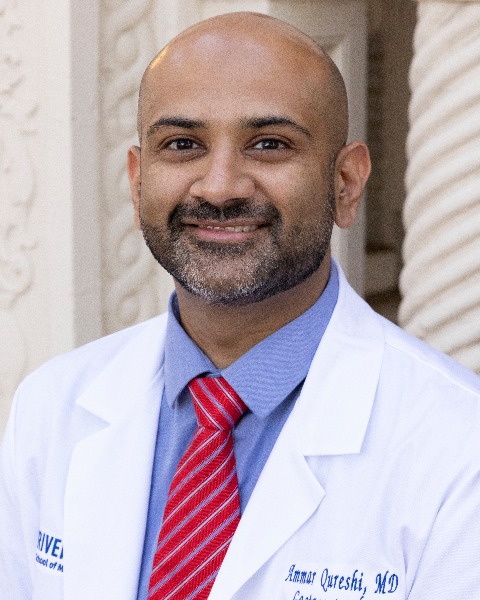Monday Poster Session
Category: General Endoscopy
P2000 - A Rare Instance of Endoscopic Enteric Tube Placement in a Patient With Untreated Bochdalek Hernia
Monday, October 23, 2023
10:30 AM - 4:15 PM PT
Location: Exhibit Hall

Has Audio

Ammar Qureshi, MD
University of California Riverside School of Medicine
Riverside, CA
Presenting Author(s)
Darshi Desai, MD1, Mahtab Naji, MD2, Khaled AlSmadi, MD2, Aditya Desai, MD2, Ammar Qureshi, MD2, George Saffouri, MD2
1UC Riverside School of Medicine, Riverside, CA; 2University of California Riverside School of Medicine, Riverside, CA
Introduction: Bochdalek hernia (BH) is a congenital diaphragmatic hernia incidentally found in adults. It is characterized by protrusion of abdominal viscera into the thorax through a defect in the diaphragm. Bedside insertion of nasoenteral tubes (NET) can be challenging. We present a rare case of BH where an endoscopic placement of a NET was attempted.
Case Description/Methods: A 75-year-old male with multiple medical comorbidities, presented to the hospital with acute on chronic hypoxic respiratory failure from aspiration pneumonia as evidenced on imaging. He had to be intubated and mechanically ventilated for both respiratory support and airway protection. A CT scan of the chest was obtained that showed a Bochdalek hernia with the majority of the stomach above the left hemidiaphragm. Notably, the patient had been admitted previously several times for aspiration pneumonia, hence it was suspected that the diaphragmatic hernia was the likely cause of aspiration pneumonia. Multiple attempts to place a nasogastric tube (NGT) failed, however, given that the tube would only terminate in the gastric body, there was concern that this would increase the risk of aspiration. Hence, gastroenterology was consulted for possible endoscopic placement of an NGT into the duodenum.
First, a nylon suture was used to create a loop at the tip of the NGT ex vivo. The gastroscope was advanced into the stomach while the NGT was inserted bedside alongside the gastroscope. The suture loop was grasped with a through-the-scope (TTS) hemostatic clip and then advanced into the bulb of the duodenum. The TTS clip was then used to attach the NGT to the duodenal mucosa. Post-procedural imaging confirmed the NGT in the duodenum.
Discussion: Bochdalek hernia presenting with an intrathoracic stomach would be a contraindication to the placement of a percutaneous gastrostomy tube. A major challenge of endoscopic insertion of NET is the migration of the feeding tube during the withdrawal of the scope. Hence the NGT was secured using the TTS clip. Other methods of endoscopic post-pyloric NET insertion as per literature also include using a guidewire or a therapeutic scope to introduce the NET directly. Endoscopic placement of NET has very few indications such as esophageal obstructions, delayed gastric emptying with severe regurgitation, or rarely in acute pancreatitis. The above case highlights a rare circumstance with respect to both findings of a congenital unrepaired BH in an adult while at the same time presenting a dilemma of NET insertion.

Disclosures:
Darshi Desai, MD1, Mahtab Naji, MD2, Khaled AlSmadi, MD2, Aditya Desai, MD2, Ammar Qureshi, MD2, George Saffouri, MD2. P2000 - A Rare Instance of Endoscopic Enteric Tube Placement in a Patient With Untreated Bochdalek Hernia, ACG 2023 Annual Scientific Meeting Abstracts. Vancouver, BC, Canada: American College of Gastroenterology.
1UC Riverside School of Medicine, Riverside, CA; 2University of California Riverside School of Medicine, Riverside, CA
Introduction: Bochdalek hernia (BH) is a congenital diaphragmatic hernia incidentally found in adults. It is characterized by protrusion of abdominal viscera into the thorax through a defect in the diaphragm. Bedside insertion of nasoenteral tubes (NET) can be challenging. We present a rare case of BH where an endoscopic placement of a NET was attempted.
Case Description/Methods: A 75-year-old male with multiple medical comorbidities, presented to the hospital with acute on chronic hypoxic respiratory failure from aspiration pneumonia as evidenced on imaging. He had to be intubated and mechanically ventilated for both respiratory support and airway protection. A CT scan of the chest was obtained that showed a Bochdalek hernia with the majority of the stomach above the left hemidiaphragm. Notably, the patient had been admitted previously several times for aspiration pneumonia, hence it was suspected that the diaphragmatic hernia was the likely cause of aspiration pneumonia. Multiple attempts to place a nasogastric tube (NGT) failed, however, given that the tube would only terminate in the gastric body, there was concern that this would increase the risk of aspiration. Hence, gastroenterology was consulted for possible endoscopic placement of an NGT into the duodenum.
First, a nylon suture was used to create a loop at the tip of the NGT ex vivo. The gastroscope was advanced into the stomach while the NGT was inserted bedside alongside the gastroscope. The suture loop was grasped with a through-the-scope (TTS) hemostatic clip and then advanced into the bulb of the duodenum. The TTS clip was then used to attach the NGT to the duodenal mucosa. Post-procedural imaging confirmed the NGT in the duodenum.
Discussion: Bochdalek hernia presenting with an intrathoracic stomach would be a contraindication to the placement of a percutaneous gastrostomy tube. A major challenge of endoscopic insertion of NET is the migration of the feeding tube during the withdrawal of the scope. Hence the NGT was secured using the TTS clip. Other methods of endoscopic post-pyloric NET insertion as per literature also include using a guidewire or a therapeutic scope to introduce the NET directly. Endoscopic placement of NET has very few indications such as esophageal obstructions, delayed gastric emptying with severe regurgitation, or rarely in acute pancreatitis. The above case highlights a rare circumstance with respect to both findings of a congenital unrepaired BH in an adult while at the same time presenting a dilemma of NET insertion.

Figure: Image 1: Endoscopic view of NG tube placement
Images 2 and 3: CT scan of the chest and Abdomen showing the presence of abdominal viscera inside the thoracic cavity
Image 4:
Green arrow - Failed NG tube
Red arrow - Antrum
Yellow arrow - Proximal gastric body
Images 2 and 3: CT scan of the chest and Abdomen showing the presence of abdominal viscera inside the thoracic cavity
Image 4:
Green arrow - Failed NG tube
Red arrow - Antrum
Yellow arrow - Proximal gastric body
Disclosures:
Darshi Desai indicated no relevant financial relationships.
Mahtab Naji indicated no relevant financial relationships.
Khaled AlSmadi indicated no relevant financial relationships.
Aditya Desai indicated no relevant financial relationships.
Ammar Qureshi indicated no relevant financial relationships.
George Saffouri indicated no relevant financial relationships.
Darshi Desai, MD1, Mahtab Naji, MD2, Khaled AlSmadi, MD2, Aditya Desai, MD2, Ammar Qureshi, MD2, George Saffouri, MD2. P2000 - A Rare Instance of Endoscopic Enteric Tube Placement in a Patient With Untreated Bochdalek Hernia, ACG 2023 Annual Scientific Meeting Abstracts. Vancouver, BC, Canada: American College of Gastroenterology.
